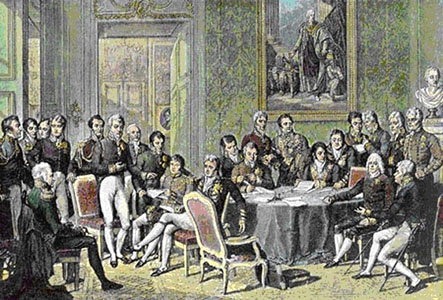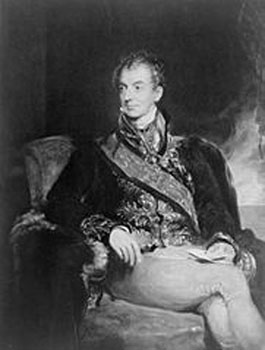Learn
Alliance
After his defeat at Waterloo, Napoleon was exiled to the Island of St. Helena and the work of redrawing the map of Europe was left to the Congress of Vienna - an alliance of those countries who had opposed Napoleon. What were those nations opposed to Napoleon and who led them? Think for just a moment - which countries did Napoleon attack and overcome? Which did he attack and not overcome. That should help you to narrow down the list. The chart below should help you too!
| Alliance Name | Participants | Specific Goals |
|---|---|---|
| Quadruple Alliance, 1814 | Austria, Prussia, Russia, Great Britain | To preserve Europe from revolutionary movements; To ensure that France carried out terms of the peace. |
| Holy Alliance, 1815 | All rulers of Europe except for King of England, Turkish Sultan, and the Pope. | Rulers pledged to rule as Christian princes, but Great Britain refused to sign. |
| Quintuple Alliance, 1818 | Austria, Prussia, Russia, Great Britain AND France | Same goals as Quadruple Alliance of 1814. |
Quadruple Alliance
The Quadruple Alliance Austria, Prussia, Russia, Great Britain worked together to try to restore the balance of power. In 1815, the Congress of Vienna met and the meeting was composed of allies of the Quadruple Alliance, France and smaller states to work out a settlement to bring a fair peace. This Concert of Europe would jointly work to protect border changes made at Vienna and keep the peace.

Conservatism, Liberalism, and Nationalism
There were several forces in politics at work at the meeting — remember that this was known as the Age of Isms.
- Conservatism - the desire to keep the traditional ways with the monarchies and upper classes ruling as it was before the Enlightenment. People in this group were known as Reactionaries.
- Liberalism - stress was on individual freedoms and equality. The middle class supporters wanted all people to vote but only the educated to govern (supporters of the Bill of Rights and the Declaration of the Rights of Man).
- Nationalism - this movement stressed campaigns in one’s homelands. Essentially, this group was not satisfied with going back to the way things were.
Leaders in the Congress
Delegates at the Congress of Vienna wanted to bring back conservatism and block liberal and nationalist ideas. Who were these leaders? Who took the lead in the Congress? Be sure to know them for your unit test!
| Countries | Leaders |
|---|---|
| Austria |
Prince Klemens von Metternich (Chief) He'd spent 25 years at war and felt liberalism and nationalism were a threat to the Austrian Empire. He fought them both at all costs. |
| Prussia | King Frederick William III |
| Russia | Czar Alexander |
| Great Britain | Lord Castlereagh |
| France | Prince Talleyrand - remember how France had upset the balance of power in Europe and was responsible for the need for the meeting. Do you think it might have been difficult to be in his place? |
What were the top aims of the meeting?
- Restore the balance of power
- Restore the ruling families of each country (known as Legitimacy)
- Remove the freedoms gained by the general population
- Build a lasting peace
Did problems arise in this meeting? What were they?
- Conflicts over the redrawn borders and the pledge to accept them
- French neighbors were strengthened
- Switzerland regained its independence
- Netherlands and Belgium became one kingdom
- The Piedmont in northern Italy was taken from France and given to the Kingdom of Sardinia
- Austria gained two Italian states: Lombardy and Venetia
- Sweden received Norway
- Great Britain kept overseas possessions
- Prussia was not pleased with its land grants
- France’s new status as a European power
- Metternich aligned 39 German states under Austrian control - upset the balance of power among the German states.
Were there far-reaching results that occurred because of this meeting?
Of course! There were challenges to Conservatism - the Metternich System of providing assistance to fellow nations was established that encouraged rulers to put down any threats to the established order of rule. Despite that, there were problems. Kings put repressive measures like the Carlsbad Decrees a spy system that censored books and newspapers and imprisoned many in the German Confederation.

There were also Nationalist revolutions, some that were crushed by the rulers and others that were successful:
- In Spain in 1820
- In Italy crushed by Austria in 1820
- Decembrist Revolt in Russia crushed by Czar Nicholas I, 1825
- Greece pushes Turks out with the help of Britain, France and Russia in 1829 and wins independence
- French July Revolution of 1830 overthrows Charles X and places King Louis Philippe, the Citizen King, on the throne, but things still remained unsettled.
- Belgium gained independence from the Netherlands in 1831.
- Poland revolted against Russia in 1831 but the revolt was crushed.
Now, take a few moments to look at the map below after the Congress of Vienna. Notice some of the changes that have taken place.

- Sweden received Norway
- Netherlands and Belgium became one kingdom
- Great Britain kept overseas possessions
- French neighbors were strengthened
- The Piedmont in northern Italy was taken from France and given to the Kingdom of Sardinia
- Switzerland regained its independence
- Austria gained two Italian states: Lombard and Venetia
- Prussia was not pleased with its land grants